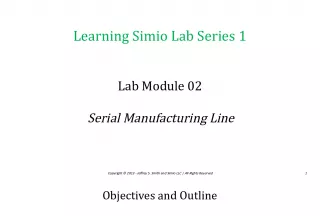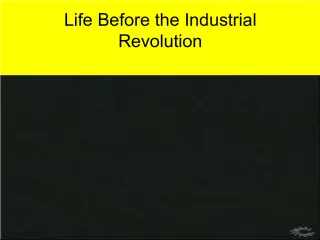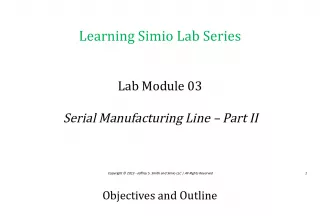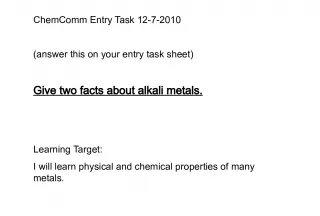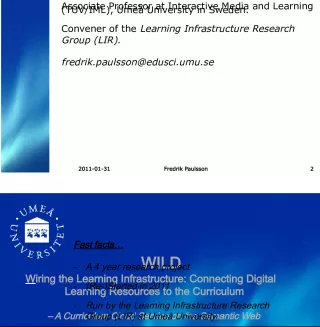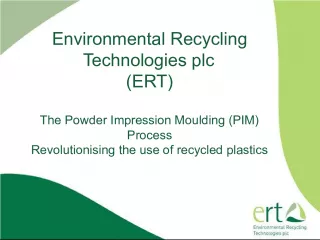Plastic Manufacturing Learning Task


This learning task involves identifying materials and manufacturing processes used in plastic production. Students will examine various plastic items to identify the material, justify the material choice, and explain the manufacturing method used.
- Uploaded on | 0 Views
-
 aylinfisher
aylinfisher
About Plastic Manufacturing Learning Task
PowerPoint presentation about 'Plastic Manufacturing Learning Task'. This presentation describes the topic on This learning task involves identifying materials and manufacturing processes used in plastic production. Students will examine various plastic items to identify the material, justify the material choice, and explain the manufacturing method used.. The key topics included in this slideshow are plastics, manufacturing processes, material choice, injection moulding, visual evidence,. Download this presentation absolutely free.
Presentation Transcript
1. Materials and Processes Learning Tasks and Questions S. Smith - Higher Product Design
2. Production in Plastics S. Smith - Higher Product Design
3. Plastics At each station you will find an item manufactured in plastic. You will be given 5 minutes at each station to (a) Identify the material used. (1 mark) (b) Justify the choice of the material used in the manufacture of each item. (2 marks) (c) State the method of manufacture and explain what visual evidence indicates this manufacture method. (2 marks) e.g. Polypropylene is a suitable choice of plastic for the manufacture of the lamp as it is suited to injection moulding. Polypropylene is also a rigid plastic, which is important as the lamp needs to be sturdy. e.g. The lamp has been injection moulded. The visual evidence that indicates that the lamp has been injection moulded are the ejection pin marks on the underside. S. Smith - Higher Product Design
4. 1. Fruit Smoothie Drinks Bottle The bottle was manufactured by the process of blow moulding and the lid was manufactured by the process of injection moulding. (a) Justify why each of these two processes were used to manufacture these components. (4 marks) (b) State and Justify a plastic that could be used for the bottle or cap. (2 marks) Extension The companys advert makes several statements about the features of products packaging. (c) From a consumers point of view, describe how these features may make a product more appealing. (2 mark) A plastic bottle and lid are shown in the advert below. S. Smith - Higher Product Design
5. Flat Seat Price Rotational moulded Polypropylene. Stainless steel hangers. Safety tested to hold a weight of 2100 kg. .Recommended for use by children aged 5years and over. Suitable for use by adults up to the 95 th percentile. The two swing seats shown are both mass produced by the same company. The company explain that the seats can be hung from a tree branch or a swing frame. (a) Give four reasons why these chairs are suitable for mass production. (4 marks) (b) Justify Polypropylene as the choice of material in the production of the seats. (4 marks) Extension (c) Outline a product specification for these types of chairs. (6 marks) (d) Describe the appeal of both seats from a consumers viewpoint. (4 marks) Enclosed Infant Seat Price Rotational moulded Polypropylene. Stainless steel hangers. Available in a variety of colours. Safety Tested to hold a weight of up to 2200 kg. Recommended for use by infants between 6 months 3 years.
6. 3. Electrical Light Switch S. Smith - Higher Product Design Shown left is an electrical fitting that has been manufactured using the process of compression moulding. (a) State and justify a plastic that could be used for this product. (2 marks) (b) Describe the visual evidence that would indicate that a product had been compression moulded? (2 mark) Extension Designers can sometimes use niche marketing to increase their sales. (c) With reference to the light switch below, describe what is meant by the term niche marketing. (2 marks)
7. 4. Chocolate Packaging S. Smith - Higher Product Design Chocolates and their packaging are shown below (a) Name and justify a suitable method of producing the packaging. (3 marks) (b) Name and justify a suitable plastic for this process. (3 marks) Extension (c) Explain the health, safety and environmental issues associated with the production and use the chocolate packaging shown. (4)
8. Production in Wood Hardwoods Softwoods Manufactured Boards S. Smith - Higher Product Design
9. Develop Your Expertise (25 Min) In your groups Develop your expertise in your allocated subject (hardwood, softwood or manufactured boards) . You can use the internet, Product Design course notes or other books to research your subject. Each member of the group must understand their subject and be comfortable teaching it to others. You need to know - Think about how you want to teach your subject to other people. Do you want to use an activity, poster or ICT? As a group you must ensure that each member of the team makes an equal contribution. Examples of this type of wood Identifying Features Properties/ Advantages Uses and be able to justify them S. Smith - Higher Product Design
10. Sharing our Expertise You will be given 2 minutes to ensure that each member of your team now understands the properties and some of the uses of your material of expertise. Each team member will be given a number. These numbers will form a new group of 3 which is made up of experts, but each with a different area of expertise. S. Smith - Higher Product Design
11. 5. Flat pack Kitchen Unit An assembled flat pack kitchen unit and kitchen work surface are shown below. (a) Describe the benefits of using Chipboard with a melamine formaldehyde laminate for the kitchen worktop. (4 marks) (b) Explain why manufacturers are now using modern construction techniques in favour of traditional methods. (3 marks) Extension Ergonomic issues have to be considered in the design of kitchen units. (a) Describe what the implications would be for the user if anthropometrics were not properly considered by the designer of the unit.(2 marks) S. Smith - Higher Product Design Assembled using knock down fittings Chip board with melamine formaldehyde laminate work surface. Knock-down-fitting used in the assembly of the kitchen unit
12. Production in Metals S. Smith - Higher Product Design
13. Metals At each station you will find an item manufactured in metal. You will be given 5 minutes at each station to (a) Identify the material used and state how you are able to recognise this material. (1 mark) (b) Justify the choice of the material used in the manufacture of each item. (2 marks) (c) State the method of manufacture and explain what indicates this method of manufacture. (2 marks) e.g. Sheet Stainless steel is a suitable material choice for the sink because it is resistant to corrosion which is important because the product will constantly come into contact with water. Also, sheet stainless steel is a suitable material to use in the press forming manufacture process. e.g. The sink has been manufactured using the process of press forming. There are no sharp corners on the shaped parts of the sink. Sharp corners are avoided in press forming as they can result in the sheet material being thin and weak. S. Smith - Higher Product Design
14. 2. Stainless Steel Ice Cream Scoop S. Smith - Higher Product Design
15. 6. Toy Car S. Smith - Higher Product Design Die cast body and Doors A mass produced toy car is shown below. Poly-methacrylate (acrylic) windows (a) State and justify one metal that is suitable for the manufacture of the doors and body of the toy car. (2 marks) (b) Describe what visual evidence would suggest that the parts had been produced using die casting. (2 marks) (c) Explain why the manufacturer might have elected to use acrylic rather than glass for the windows. (1 mark) Extension This car could appeal to several different consumer groups. (d) Describe the quality issues involved for: the parent of a child user; an adult toy collector. (6 marks)
16. 7. Spaghetti Spoon S. Smith - Higher Product Design Below and right is a kitchen utensil designed to help the user serve spaghetti. The utensil has been produced using a process of piercing, blanking and press forming. (a) Explain why the utensil is suitable for mass production. (3 marks) (b) State and justify a suitable metal for the production of the kitchen utensil. (2 marks) Extension (c) With reference to the manufacture of this item describe the Just In Time (JIT) method of production. (2 marks) (d) Discuss the advantages and disadvantages of this type of production. (2 marks)
17. 8. Spanner Find a good drop forged product. S. Smith - Higher Product Design
18. 4. Le-Creuset kitchen ware. S. Smith - Higher Product Design A top-of-the-range kitchen ware set is shown below. The kitchen ware has been produced by the process of sand casting and finished with a blue enamel. (a) Explain why most manufactures would choose not to use sand casting for a product that has to be mass produced. (2 marks) (b) State and justify one material suitable for all of these products. (2 marks) Non- stick coating Extension The non-stick coating used on the frying pan was originally developed for space research. (c) With reference to the non-stick coating used on the frying pan, explain what is meant by the term technology Transfer. (2 marks)
19. 1. Curvy Stackable Chair Injection Moulded Seat Bent Tubing Legs (a) Explain why injection moulding is a suitable production method for the seat. (2 marks) (b) What visual evidence would indicate that the seat had been injection moulded. (2 marks) (c) Give valid reasons why a designer would elect to use extrusions to manufacture the steel tubing for the legs. (2 marks) (d) State a suitable material for both the seat and the legs (2 marks) Extension A designer was asked to design a new chair for a company. (e) Explain why it would be important for the designer to meet their client to agree upon a brief. (4 marks) (f) Explain why a designer may wish to have an open brief rather than a closed brief . S. Smith - Higher Product Design
20. A good product with questions about extrusion in metals and plastics. Possibly about electrical wire and insulation. S. Smith - Higher Product Design
